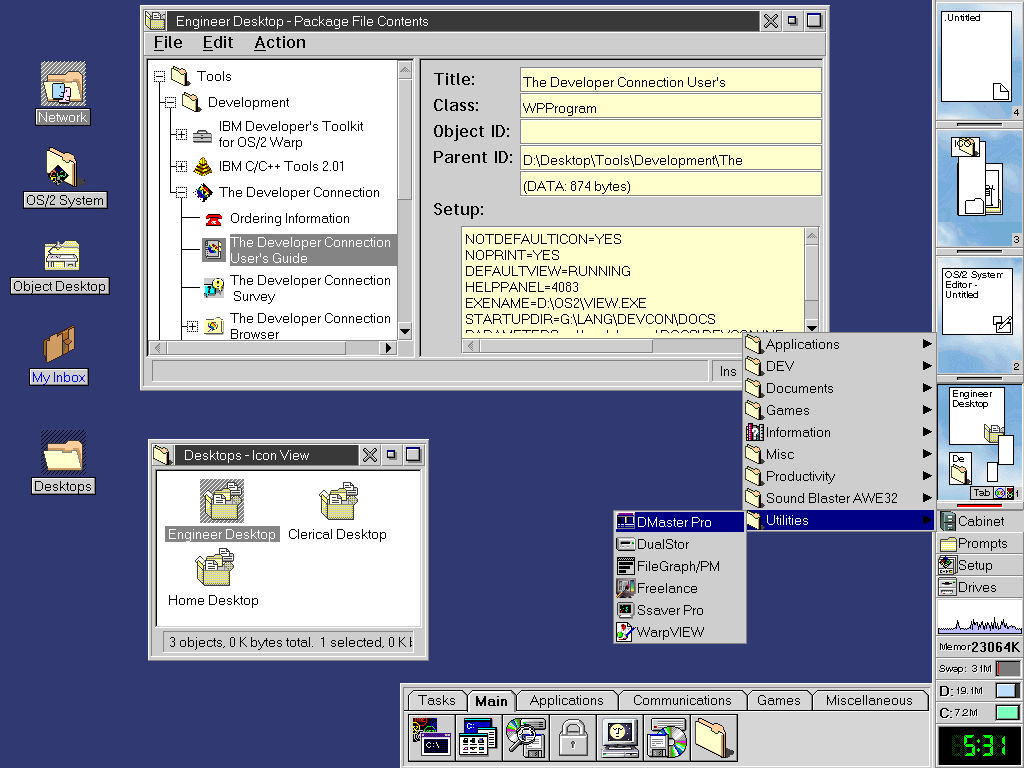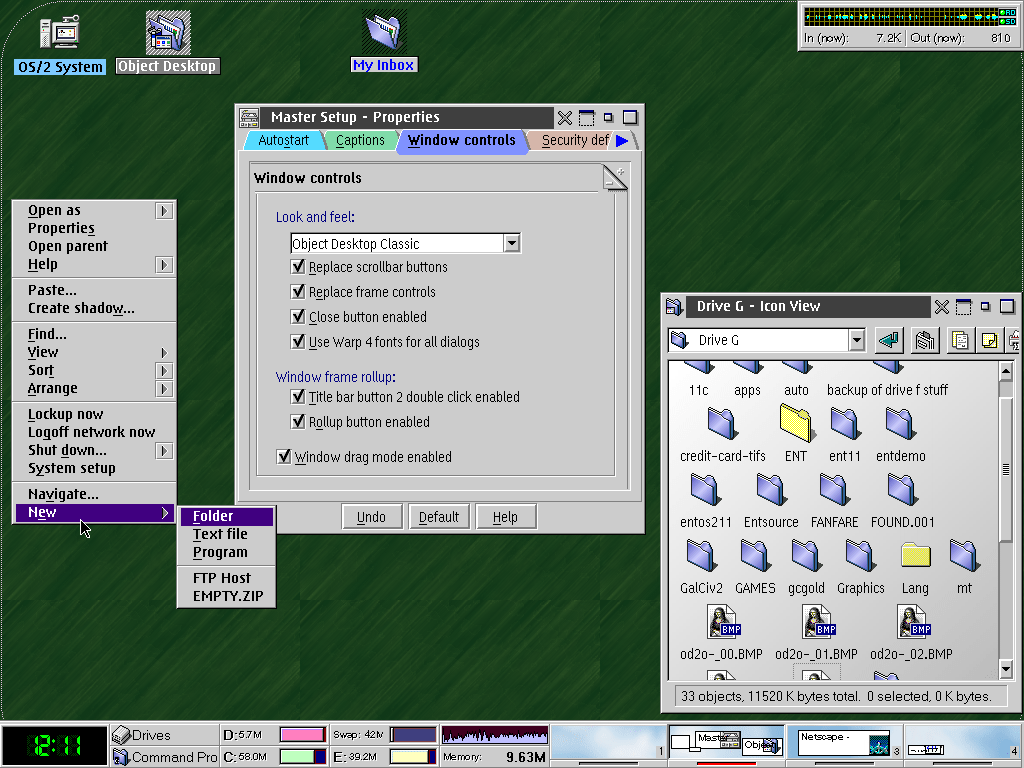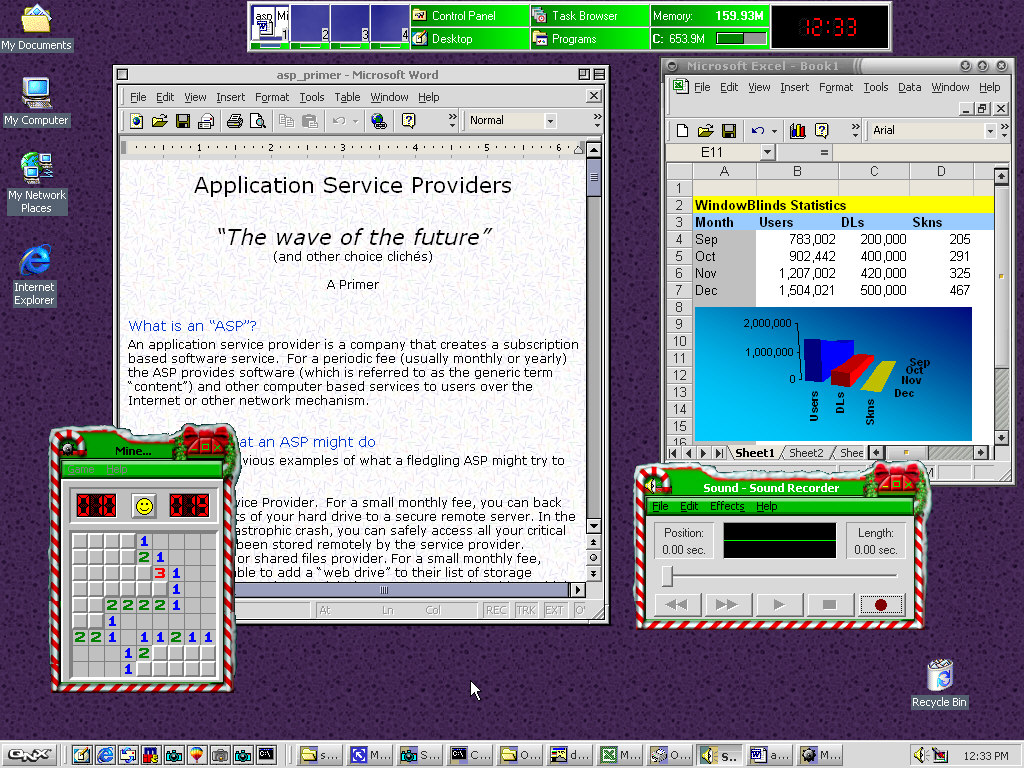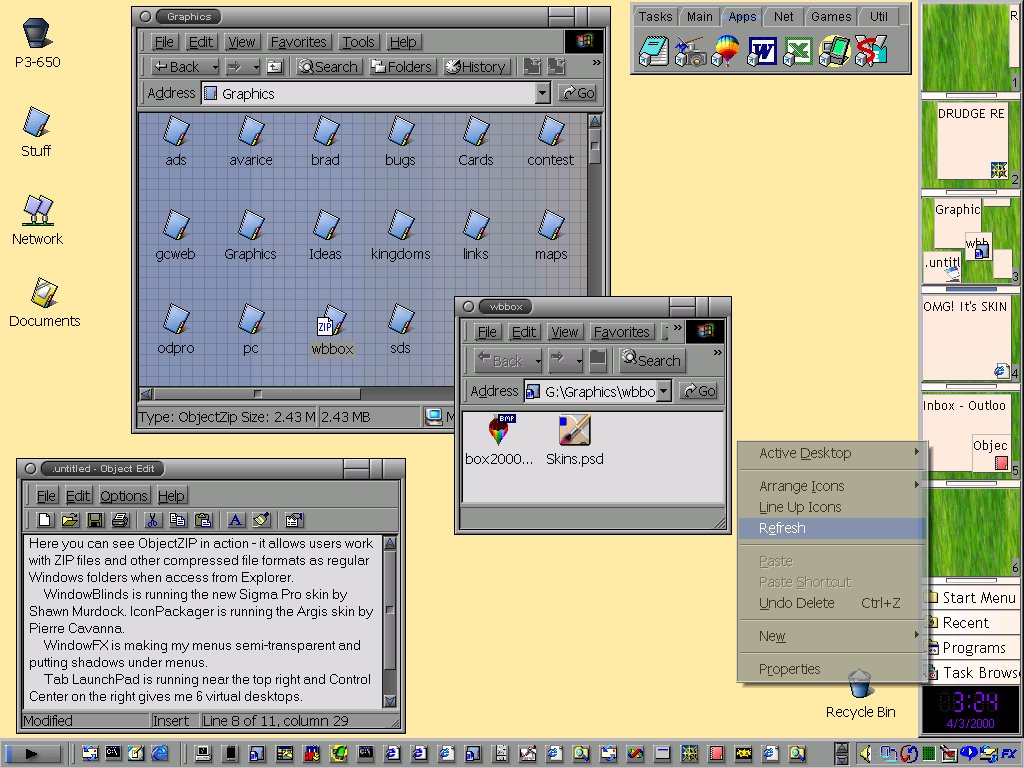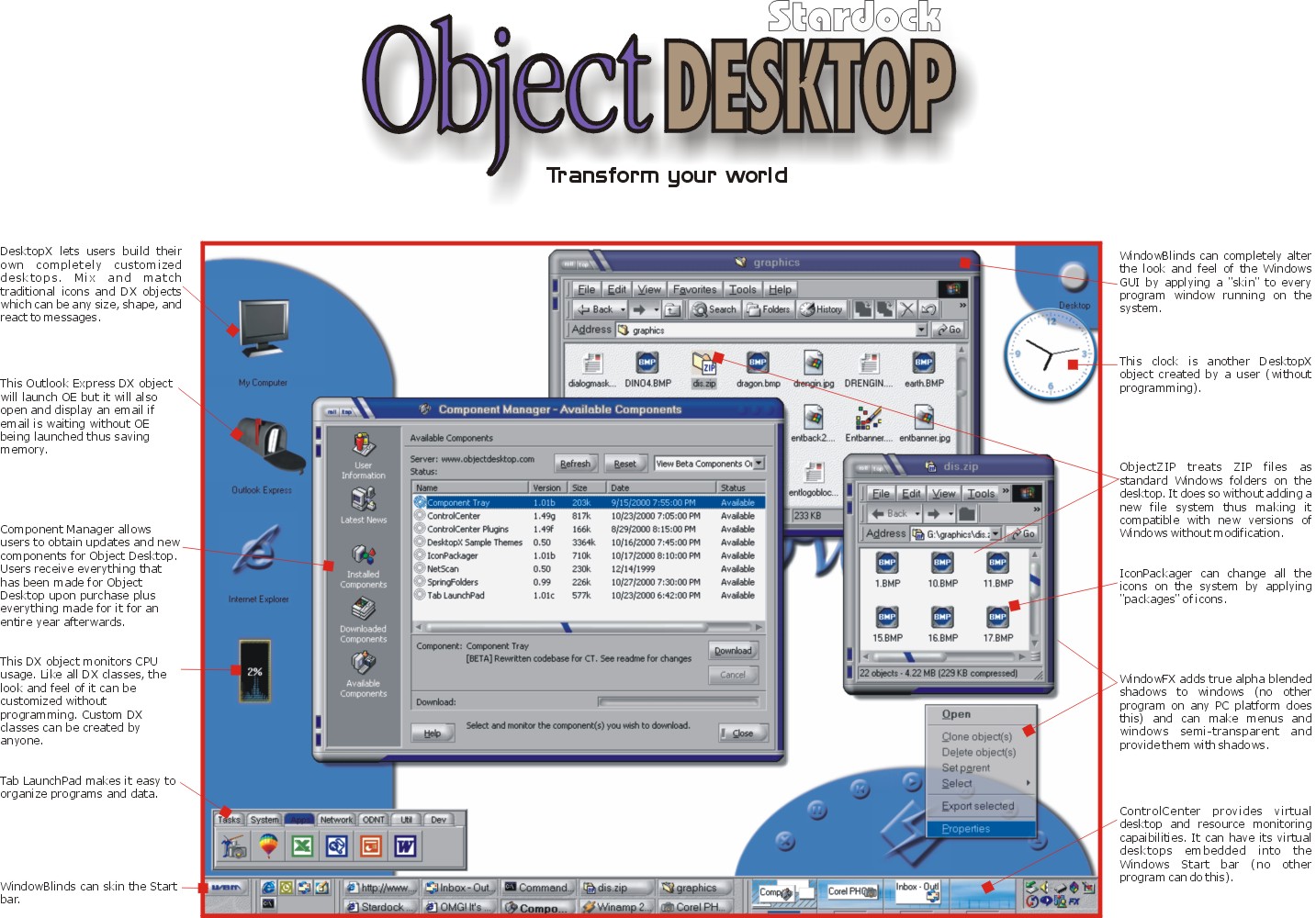Object Desktop History: Difference between revisions
Island Dog (talk | contribs) No edit summary |
Island Dog (talk | contribs) No edit summary |
||
| Line 16: | Line 16: | ||
[[File:Od1.gif|350px]] | [[File:Od1.gif|350px]] | ||
===1996-1998=== | ===1996-1998=== | ||
| Line 34: | Line 33: | ||
[[File:Od20-5.gif|350px]] | [[File:Od20-5.gif|350px]] | ||
===Object Desktop comes to Windows...=== | |||
In 1997, Stardock began working on Object Desktop for Windows. But on Windows, Stardock faced two challenges. The first one is the age old question, "What is to stop Microsoft or some other huge company from just taking your ideas and putting them into their OS or bundling them with some massively popular program?" The second was the issue of the decline of the OS/2 market. The OS/2 market's decline was very rapid in 1997 and most of the well known OS/2 ISVs disappeared between 1997 to 1998 (or went to Windows). Stardock's challenge was how to pay for the development of Object Desktop? | |||
The answer to both came in the form of the Object Desktop Network (ODNT). The idea was that instead of there being an Object Desktop 1.0 for Windows, it would simply be available as a subscription. Users would just buy Object Desktop electronically and get all the software already on there plus everything new for a full year afterwards. This, in effect, allowed Stardock to constantly update its software to evolve as Windows evolved. And secondly, it allowed Stardock to provide something to customers before it Object Desktop was fully completed. Thanks to the loyalty of its OS/2 customers, who had, like Stardock, switched to Windows, Stardock was able to afford to make Object Desktop for Windows. | |||
===1999-2000=== | |||
In December of 1999, Stardock officially released the Object Desktop Network. That is, subscriptions would start to count. The ability to skin scrollbars was a pretty big deal at the time (December 1999). It was, and still is, one of the features that the "free" version of WindowBlinds stand alone doesn't support. | |||
[[File:Odnt-dec99.jpg|350px]] | |||
By early 2000, Stardock was in the position of where Object Desktop did the "main" things that the OS/2 version did. Windows itself had evolved over the years to make some of Object Desktop's features from OS/2 redundant or simply weren't applicable. So it was time to start putting together the "new" stuff. The stuff that wasn't on the OS/2 version at all. | |||
That meant that it was time for DesktopX. The concept from 1997 in which the long talked about Microsoft "Cairo" and IBM/Apple Taligent ideas would come together. And the release of Windows 2000 opened the door to the component that could make use of the new visual APIs to create WindowFX... | |||
[[File:Odnt-apr00.jpg|350px]] | |||
[[File:Odnt-nov00.jpg|350px]] | |||
Revision as of 14:44, 11 September 2020
1995
No one knows who the first to "Skin" something was. But we do know that in 1995, Stardock, a young up and coming software developer released Object Desktop for OS/2. In development for 2 years, Object Desktop was truly a remarkable technological achievement. And it would go on to be the best selling OS/2-specific shrink wrapped package of all time. What Object Desktop did is allow people to enhance the OS/2 desktop to how they wanted it. In OS/2's case, it was usually used to tame the wild OS/2 desktop (called the workplace shell). IBM's view with OS/2 was to make it supremely flexible.
For this part of the history, it is important to remember the key year Object Desktop was developed: 1994. It was the time of Windows 3.1 and DOS. ZIP programs consisted of either very crude GUI programs or PKZIP on DOS. File management was the Windows File Manager or Norton Commander. Virtual desktops on DOS/Windows (or OS/2) were largely unknown. The more you remember the state of the PC in 1994 the more remarkable Object Desktop becomes.
Object Desktop added to OS/2:
- An enhanced visual look (the term "skinning" had not been coined yet).
- The ControlCenter with resource monitoring, virtual desktops, and program launching
- The Tab LaunchPad which made it easy to organize your programs
- Integrated ZIP into the actual file system. ZIP files behaved like any other folder (yes, we were the first to do this).
- A way to package your desktop into a single file or parts of it. Imagine on Windows being able to drag and drop your favorite program into a "package" and having all its registry and class registrations automatically handled seamlessly.
- A Keyboard LaunchPad to launch programs, links, and groups of programs.
And hundreds of enhancements to the OS that were so seamless that many users would come to believe they were part of the OS.
1996-1998
Object Desktop became the most popular non-IBM product on OS/2. Machines that came with OS/2 already installed typically came with Object Desktop with it. And Stardock had more ideas on where computer operating systems could go. IBM asked Stardock's Brad Wardell to come to Austin to discuss what the OS/2 Warp 4 desktop should be. The result is that IBM's OS/2 Warp 4's desktop was simplified and a close button added (in the position Object Desktop placed it).
At the same time, Stardock released Object Desktop Professional version 1.5 and then Object Desktop 2.0.
Object Desktop Pro 1.5 added 3 revolutionary new features:
- Universal File Viewing
- Web spaces on the desktop
- Folder Security
As with much of this history, the timing of these innovations is crucial. Today, the idea of having the web as part of the desktop seems straight forward. Windows 98 introduced Active Desktop. But Object Desktop Professional was developed in 1995.
In Object Desktop 2.0, Stardock combined its original folder design with Microsoft's Explorer design to create a new type of folder window. It also introduced Dynamic Interface Modules (DIMs) which was Stardock's dorky name for "Skins" back then.
Object Desktop comes to Windows...
In 1997, Stardock began working on Object Desktop for Windows. But on Windows, Stardock faced two challenges. The first one is the age old question, "What is to stop Microsoft or some other huge company from just taking your ideas and putting them into their OS or bundling them with some massively popular program?" The second was the issue of the decline of the OS/2 market. The OS/2 market's decline was very rapid in 1997 and most of the well known OS/2 ISVs disappeared between 1997 to 1998 (or went to Windows). Stardock's challenge was how to pay for the development of Object Desktop?
The answer to both came in the form of the Object Desktop Network (ODNT). The idea was that instead of there being an Object Desktop 1.0 for Windows, it would simply be available as a subscription. Users would just buy Object Desktop electronically and get all the software already on there plus everything new for a full year afterwards. This, in effect, allowed Stardock to constantly update its software to evolve as Windows evolved. And secondly, it allowed Stardock to provide something to customers before it Object Desktop was fully completed. Thanks to the loyalty of its OS/2 customers, who had, like Stardock, switched to Windows, Stardock was able to afford to make Object Desktop for Windows.
1999-2000
In December of 1999, Stardock officially released the Object Desktop Network. That is, subscriptions would start to count. The ability to skin scrollbars was a pretty big deal at the time (December 1999). It was, and still is, one of the features that the "free" version of WindowBlinds stand alone doesn't support.
By early 2000, Stardock was in the position of where Object Desktop did the "main" things that the OS/2 version did. Windows itself had evolved over the years to make some of Object Desktop's features from OS/2 redundant or simply weren't applicable. So it was time to start putting together the "new" stuff. The stuff that wasn't on the OS/2 version at all.
That meant that it was time for DesktopX. The concept from 1997 in which the long talked about Microsoft "Cairo" and IBM/Apple Taligent ideas would come together. And the release of Windows 2000 opened the door to the component that could make use of the new visual APIs to create WindowFX...
